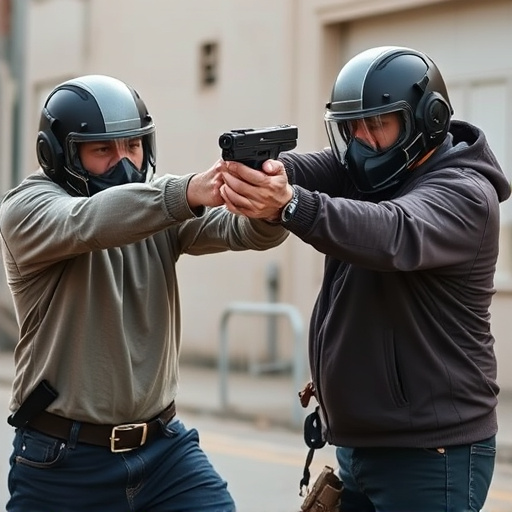Exposure to pepper spray requires immediate action: remove contaminated clothing, rinse eyes with water for 15+ minutes, seek fresh air. Symptoms vary in severity and may include eye irritation, respiratory distress, nausea, and temporary blindness. Medical attention is crucial if symptoms persist or worsen, especially for those with pre-existing conditions. Key treatments involve eye irrigation, topical hydrocortisone, antihistamines, and prompt decontamination. Training and swift response minimize discomfort and long-term effects of pepper spray exposure.
Pepper spray, a common tool in riot control, poses significant risks. Understanding its effects, from immediate symptoms like respiratory distress and skin irritation to potential long-term damage, is crucial for both public safety and law enforcement. This article delves into the complexities of pepper spray exposure, offering guidance on immediate care, long-term management, and effective treatments for skin irritations. Learn how to navigate the aftermath and prevent future incidents with these essential tips on How to Treat Pepper Spray Exposure.
- Understanding Pepper Spray Exposure
- Symptoms of Inflammatory Spray Reactions
- Immediate Care After Exposure
- Long-Term Management and Prevention
- Effective Treatments for Skin Irritation
Understanding Pepper Spray Exposure
Understanding Pepper spray exposure is crucial for both those in law enforcement and members of the public. When exposed, individuals may experience a range of symptoms, from eye irritation and respiratory distress to temporary blindness and nausea. The severity can vary greatly depending on factors like the amount sprayed, duration of contact, and sensitivity of the affected areas.
Knowing how to treat pepper spray exposure is essential for minimizing discomfort and potential long-term effects. First steps include removing any contaminated clothing, rinsing eyes thoroughly with water for at least 15 minutes, and seeking fresh air. Medical attention may be necessary if symptoms persist or worsen, particularly for those with pre-existing respiratory conditions.
Symptoms of Inflammatory Spray Reactions
Inflammatory spray, commonly known as pepper spray, can cause a range of symptoms upon exposure. The primary irritants in these sprays target the eyes, nose, and respiratory system. Symptoms may include teary eyes, difficulty breathing, coughing, and temporary blindness or reduced visibility. Skin contact can lead to itching, redness, and pain. In severe cases, individuals might experience dizziness, nausea, and even panic attacks.
To treat pepper spray exposure, it’s crucial to act swiftly. Remove any contaminated clothing and wash the affected areas with mild soap and water. Seek fresh air immediately by moving to a ventilated area. Cool compresses can help alleviate eye irritation while over-the-counter antihistamines or decongestants may provide some relief from respiratory symptoms. Hydration is essential, so drink plenty of water. If symptoms persist or worsen, medical attention should be sought promptly. How to Treat Pepper Spray Exposure varies based on individual reactions, and professionals can offer tailored advice in such situations.
Immediate Care After Exposure
After exposure to inflammatory spray, such as pepper spray used in riot control, immediate care is crucial. If affected, seek fresh air immediately by moving to a well-ventilated area. This step helps dilute the irritants and alleviate symptoms. In case of eye contact, rinse both eyes thoroughly with clean water for at least 15 minutes to flush out any remaining chemicals. Do not use water from rivers, lakes, or pools as it might contain contaminants that could worsen irritation.
For skin contact, remove any contaminated clothing and wash the affected areas gently with mild soap and warm water. Avoid using harsh soaps or rubbing alcohol, as they can irritate the skin further. If breathing becomes difficult, administer oxygen if trained to do so, or help the individual to a safe, calm environment. In all cases, seek medical attention if symptoms persist or worsen, as prompt treatment can prevent complications. As for how to treat pepper spray exposure, it’s all about rapid response and gentle care to ease discomfort and ensure safety.
Long-Term Management and Prevention
After exposure to inflammatory spray, often used in riot control, proper long-term management and prevention strategies are crucial for minimizing ongoing discomfort and preventing future incidents. The first step is to thoroughly wash the affected area with plenty of water, ensuring all residual pepper spray is removed. This simple action can significantly reduce irritation and prevent further chemical reactions.
How to Treat Pepper Spray Exposure involves seeking medical attention if symptoms persist or worsen. Eye irrigation for at least 15 minutes and removing any contaminated clothing can also aid in recovery. Additionally, keeping a supply of over-the-counter antihistamines and eye drops on hand for immediate use during future encounters with inflammatory spray can provide valuable relief. Preventive measures include regular training for professionals who may come into contact with such agents, ensuring proper equipment fitting, and establishing clear decontamination protocols to quickly address exposure and mitigate its effects.
Effective Treatments for Skin Irritation
After exposure to pepper spray, it’s crucial to act quickly to alleviate skin irritation and discomfort. The first step is to rinse the affected area thoroughly with cool water for at least 15 minutes. This helps to dilute and flush out the irritant chemicals. Avoid using soap as it can further irritate the skin.
For severe cases or persistent irritation, over-the-counter or prescription topical creams containing hydrocortisone can provide relief. Antihistamines may also help reduce itching and swelling. If symptoms persist or worsen, seeking medical attention is advisable. How to Treat Pepper Spray Exposure should be a priority for individuals who frequently interact with potentially irritant substances to ensure swift and effective recovery.
Pepper spray exposure can cause significant discomfort, but with proper understanding and care, its effects can be managed. Knowing the symptoms and immediate actions to take after exposure is crucial for How to Treat Pepper Spray Exposure. Long-term management involves preventative measures and effective treatments for skin irritation. By following these guidelines, you can mitigate the impact of inflammatory spray and ensure better outcomes for those affected.
